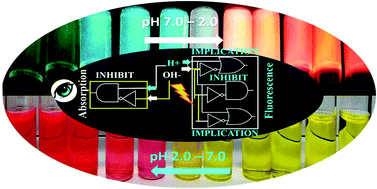Biological perspectives of a FRET based pH-probe exhibiting molecular logic gate operation with altering pH†
Abstract
Monitoring intracellular pH is a powerful tool towards understanding a variety of cellular functions and the prognosis of many diseases. In this study, an efficient multi-functionalized acidic pH sensitive probe 1, based on fluorescence resonance energy transfer (FRET) was prepared via the coupling of rhodamine B as a FRET acceptor and a naphthalimide fluorophore as a FRET donor using 1,4-diaminobutane as a nonconjugated linker. Morpholine was appended as a potential lysosome targeting group to the naphthalimide moiety. The probe features selective green to red switching in emission within the neutral to acidic pH range (pH 7.0 to pH 4.0), whereas it remains apparently unaffected in a basic medium with an observed pKa of ∼4.80. Moreover, probe 1 could be used to construct an INHIBIT logic gate and the corresponding complementary logic circuit by applying H+ and OH− ions as inputs based on the absorption and emission spectral changes, respectively. The probe showed efficient binding propensity to CT-DNA (Kb = 1.34 × 105 M−1) suggesting partial intercalation through planar moieties between the DNA base pairs. It also showed strong binding affinity for bovine serum albumin (BSA) protein (KBSA = 1.74 × 106 M−1) with efficient quenching of tryptophan fluorescence (97%) at λem = 345 nm. Interestingly, the naphthalimide fluorophore being an efficient photosensitizer enables the probe to show efficient DNA photocleavage under UV-A light (λ = 312 nm) with 65% conversion of supercoiled (SC) DNA to its nicked circular (NC) DNA form via the photo-generation of reactive oxygen species (ROS) at micromolar concentration under physiological conditions.



 Please wait while we load your content...
Please wait while we load your content...